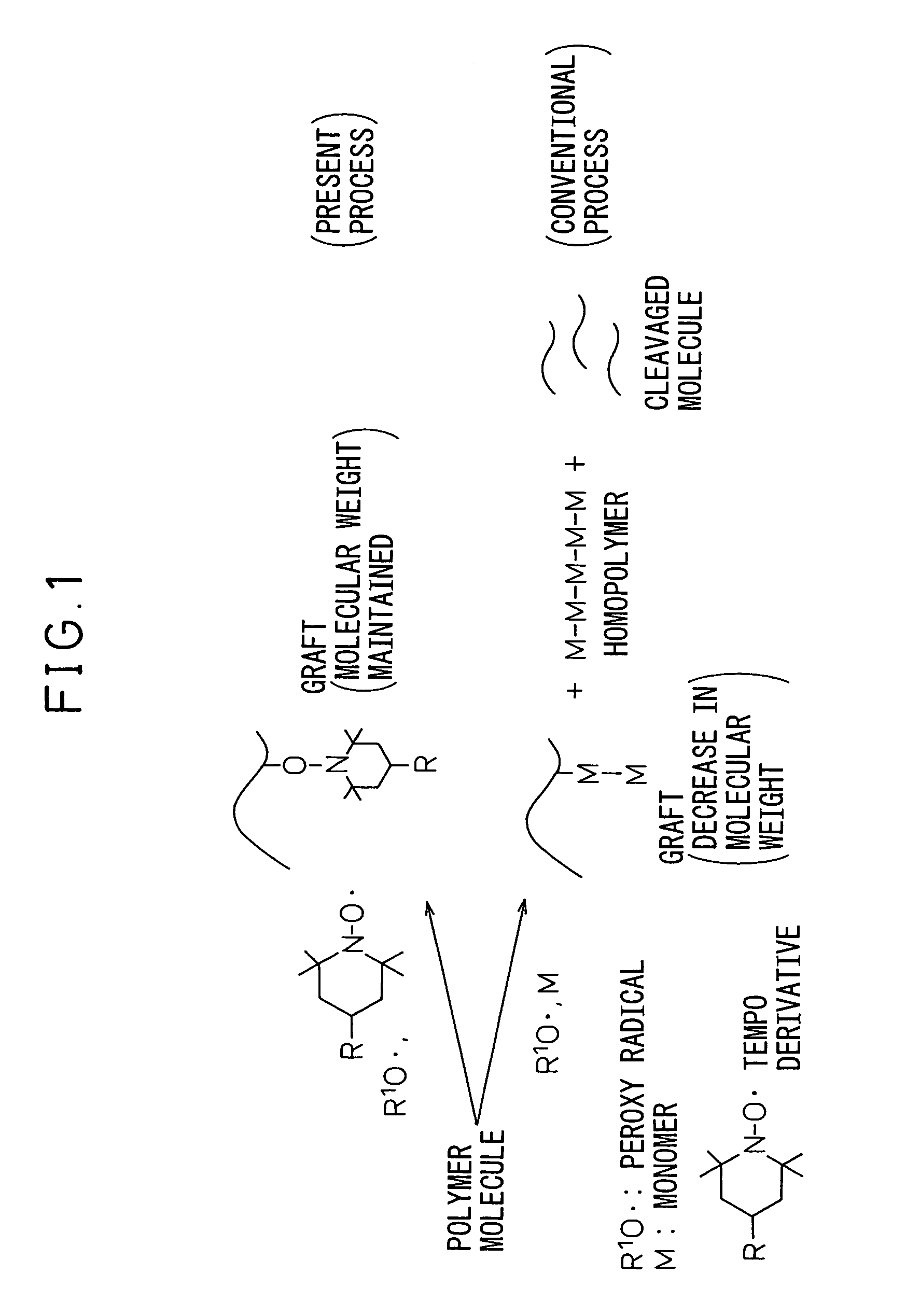Process for modification of polymer
a technology of polymer and process, applied in the field of polymer processing, can solve the problems of carbon radical generation, low unsaturation degree of butyl rubber, and low molecular weight reduction, and achieve the effect of suppressing the drop in the molecular weight of the polymer
Inactive Publication Date: 2005-10-06
YOKOHAMA RUBBER CO LTD
View PDF4 Cites 18 Cited by
- Summary
- Abstract
- Description
- Claims
- Application Information
AI Technical Summary
Benefits of technology
[0007] Accordingly, the object of the present invention is to modify a butyl rubber or ethylene-propylene copolymer (EPM) or further a thermoplastic polymer including propylene units or other radical decay type polymer by a compound having a nitroxide radical in its molecule so as to introduce functional groups while suppressing a drop in the molecular weight of the polymer.
Problems solved by technology
However, these are not technologies for positively causing the generation of carbon radicals in a polymer such as rubber and using a compound having the stable free radicals in the molecule thereof to modify the polymer.
A technique for using nitroxide radicals to modify a polymer is described in U.S. Pat. No. 4,581,429, but this introduces nitroxide radicals as counter radicals for living radical polymerization and is not used for the purpose of imparting functional groups to the polymer.
Therefore, any technology relating to a method for introducing functional groups into a radical degradation type polymer, while suppressing the decrease in the molecular weight has not yet been found.
Ordinary butyl rubber has an extremely low unsaturated degree, and therefore, is superior in weather resistance, heat resistance, ozone resistance, etc., but conversely has the defect of slow vulcanization.
Further, since halogenated butyl rubber usually is produced by dissolving butyl rubber in a hydrocarbon solvent, followed by halogenation, the number of production steps is large and the production cost is higher than the ordinary butyl rubber.
However, according to these methods, a decrease in a molecular weight and gelling of a polypropylene-based polymer occur during the modification.
Further, production of a homopolymer by a direct reaction of a functional monomer and initiator is unavoidable.
Method used
the structure of the environmentally friendly knitted fabric provided by the present invention; figure 2 Flow chart of the yarn wrapping machine for environmentally friendly knitted fabrics and storage devices; image 3 Is the parameter map of the yarn covering machine
View moreImage
Smart Image Click on the blue labels to locate them in the text.
Smart ImageViewing Examples
Examples
Experimental program
Comparison scheme
Effect test
examples
[0026] Examples will now be illustrated to further explain the present invention, but, of course, the scope of the present invention is not limited to these Examples.
the structure of the environmentally friendly knitted fabric provided by the present invention; figure 2 Flow chart of the yarn wrapping machine for environmentally friendly knitted fabrics and storage devices; image 3 Is the parameter map of the yarn covering machine
Login to View More PUM
| Property | Measurement | Unit |
|---|---|---|
| Temperature | aaaaa | aaaaa |
| Temperature | aaaaa | aaaaa |
| Temperature | aaaaa | aaaaa |
Login to View More
Abstract
A process for modification of a polymer comprising modifying a polymer (A) capable of decomposing by carbon radicals present in the molecule thereof using a compound (B) having a nitroxide radical in the molecule thereof and a radical initiator (C) in a ratio of (B) / (C) (molar ratio) of at least 0.7, whereby organic groups derived from the nitroxide radicals are introduced into the polymer and a modified unhalogenated butyl rubber obtained therefrom.
Description
BACKGROUND OF THE INVENTION [0001] 1. Field of the Invention [0002] The present invention relates to a process for modification of a polymer. More specifically, it relates to a process for modifying a polymer by reacting a polymer capable of decomposing by carbon radicals present in the molecule thereof with a compound having a nitroxide radical in the molecule thereof and a radical initiator. [0003] 2. Description of the Related Art [0004] For example, as disclosed in Japanese Unexamined Patent Publication (Kokai) No. 10-182881, it has been proposed to compound stable free radicals such as TEMPO (i.e., 2,2,6,6-tetramethyl-1-piperidinyloxy radical) into rubber to thereby improve the physical properties of the rubber composition, in particular the processability, the abrasion resistance, etc. Further, Japanese Unexamined Patent Publication (Kokai) No. 8-239510 discloses to incorporate a TEMPO derivative into a polymer to thereby prevent polymer aging. However, these are not technolog...
Claims
the structure of the environmentally friendly knitted fabric provided by the present invention; figure 2 Flow chart of the yarn wrapping machine for environmentally friendly knitted fabrics and storage devices; image 3 Is the parameter map of the yarn covering machine
Login to View More Application Information
Patent Timeline
 Login to View More
Login to View More IPC IPC(8): C08C19/22C08F2/00C08F8/30C08F36/06C08F210/02C08F210/06C08F255/02C08F255/08C08F255/10C08L15/00C08L21/00C08L23/22C08L51/06
CPCC08F8/30C08F255/02C08F255/08C08F255/10C08L23/22C08L51/06C08F10/00C08L2666/24C08L2666/02
Inventor ASHIURA, MAKOTOKAWAZURA, TETSUJI
Owner YOKOHAMA RUBBER CO LTD
Features
- R&D
- Intellectual Property
- Life Sciences
- Materials
- Tech Scout
Why Patsnap Eureka
- Unparalleled Data Quality
- Higher Quality Content
- 60% Fewer Hallucinations
Social media
Patsnap Eureka Blog
Learn More Browse by: Latest US Patents, China's latest patents, Technical Efficacy Thesaurus, Application Domain, Technology Topic, Popular Technical Reports.
© 2025 PatSnap. All rights reserved.Legal|Privacy policy|Modern Slavery Act Transparency Statement|Sitemap|About US| Contact US: help@patsnap.com



